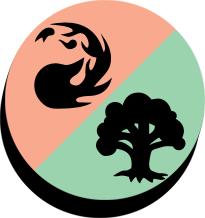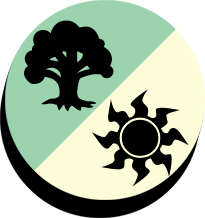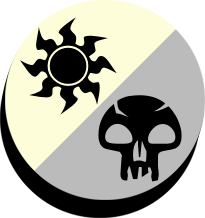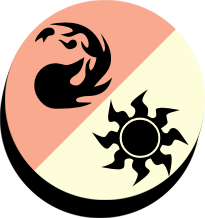| Conversation: Cardlist | Visual spoiler | Export | Booster | Comments | Search | Recent activity |
| Mechanics |
|
History: [-] Add your comments: |

| Conversation: Cardlist | Visual spoiler | Export | Booster | Comments | Search | Recent activity |
| Mechanics |
|
History: [-] Add your comments: |
Whereas the allied color pie is one side of a coin, the enemy color pie is the other side of this same coin. When certain pairs of colors are arranged around a circle, each color pair has a common enemy color. However this has only been done for half the color pairs. Thus there is an opportunity to complete the pie for the remaining color pairs. Such that each "enemy" color pair gets its single antagonist.
For instance, white-blue's enemy is red. But who is white-red's enemy? The color pie as shown to us by WotC omits this important information. If a new pie were to be developed that arranged the "enemy" colors adjacently, then it appears white-red's antagonist is actually green. That may seem counter-intuitive, because that is information that has been hidden or neglected since the beginning.
I believe this knowledge will enrich the color pie and interplay between colors, and provide new rivalries and associates. This could then extend into the mechanics and flavors of cards and stories.
I believe your premise is improper. When talking about the pie, color combination don't have enemies. It's that the two colors may or may not happen to share an enemy or ally. Besides, color combinations, designwise, are unlikely to ever be placed in opposition to monocolor factions, making it entirely unnecessary to try and figure that out anyway.
You need a six-colors pie to be able to define triads of enemies. A six-color pie gives you enemy triads, shard allies and pairs whose relationship I like to envision as very ambiguous. Here's a thread where I discussed the idea, without mechanical elaborations.
When talking about the pie, color combination don't have enemies.
Then what are Llanowar Knight and Monsoon cycles? Guttural Response.
Why are the colors that get anti-blue "can't be countered by spells or abilities." Why are
the colors that get anti-blue "can't be countered by spells or abilities." Why are  the colors that get anti-black counter-measures to discard: "If a spell or ability an opponent controls causes you to discard".
the colors that get anti-black counter-measures to discard: "If a spell or ability an opponent controls causes you to discard".
I don't know why you bring up pair-to-pair or 3v3 enemies. My idea of 2v1 is because that has the most flexibility in terms of flavor and mechanics, and easiest to conceive and pull off.
"are unlikely to ever be placed in opposition to monocolor factions"
Who knows officially what WotC will or will not do. But this is a place for fostering ideas, regardless of whether they will run with it. Moreover you proposing a 6-color pie is even more work and less likely to happen.
Whereas the alternate color pie isn't anything drastic, it's merely an extension to the existing color pie. No more than Planar Chaos. At worst, it's a one-and-done deal, contained within its own set or block, if one would do it that way but later find it is unpopular. Doesn't even have to full blown sets. Merely a singleton or cycle here or there when the time calls for it.
Especially on here, it is very easy to imagine alternate color pies and put them onto cards. But also hard to have a meaningful discussion because the ideas and comments are so spread out in many places.
In my opinion, white-red's enemy definitely isn't green. That's their mutual friend who brings them together. The enemy of white-red is generally going to be blue-black, or whichever of blue and black is more of an enemy to the white-red faction in this particular world.
Boros, a clan built around openly keeping order, hates Dimir, a clan around secret orgainizations with potentially malicious intent. Checks out.
Simic, a clan built around remaking the natural order to achieve a higher state of perfection, hates Rakdos, a clan built around celbrating random acts of violent death for hedonistic purposes. Checks out.
Selesnya, a clan built around the belief that slow cultish groupthink is spiritually superior, hates Izzet, who believes that individual sparks of genius is the ideal. Checks out.
Gruul, a clan that believes in anarchy in an attempt to revert urban environments back to their natural violent order, hates Orzhov, a clan that believes that individuals are beholden to a church created via intricate social dynamics which maintain the peace, and that parishioners are so entrenched in the system that they must pay homage both in this life, and the life hereafter. Checks out.
The Azorious, a clan built on the bureaucratic belief that life should be maintained within a set system of rules, and that order can only be kept as long as inaction among individuals is the rule, hates the Golgari who believe in the worship of power by subverting the system through transformation, often involving death, a state that puts one beyond the realm of the law. Checks... well... four out of five ain't bad.
I think of it in term of "what guild specifically undermine's another's typical activities". In that regard, philosophical opposition does not lead to enemy status, and they don't even need to be both ways. I'd assume that both Azorius and Orzhov really hate the Dimir, but I don't think Dimir sees any other guild as actual enemies.
On the other hand I wouldn't be surprised if Rakdos somewhat returned the likely animosity that Azorius and Boros have for them. (same with Azorius and Gruul)
Finally, I have some doubts that Simic (and probably Golgari) consider any other guild specifically as enemies (or the otehr way around, even). They just don't seem to have obvious clashing points with other guilds in the course of their typical guild activities. Maybe somewhat between Golgari and Selesnya?
Guild-vs-Guild has been covered by Maro in his guild philosophy articles, and they mostly check out. However that is not the goal here.
If color pie were a disk, like a coin is a disk. The main color pie that we know, the allied pie, is heads. Then the tails side of the coin would be enemy pie. It is identical in structure as allied pie, except colors are rearranged to represent new pairings. The two pies complete, complement, and coexist with each other.
Why Boros dislikes Green. Boros main archetype is weenies and combat abilities. Here you have green cheating in monsters on steroids that overcome most of Boros combative skills. Thus Boros wants to punish Green by Smite the Monstrous and Traitor's Roar. Green also cheats land into play. Boros can tax Green for having too many lands and prevent lands not played from hand.
ex. ((C72069)) , ((C72070))
Sure, sure, Boros has a different strategy than Green does. But that doesn't equal philosophical hatred for the color. If Gruul offered Boros a couple of Battering Wurms, Boros wouldn't be horrified by the idea. They would just struggle to understand how to use them properly.
If, however, Dimir offered to lend a couple of vampire spies to Boros, a number of high-ranking officials would be incensed and outraged by the prospect of housing and relying on such underhanded criminals. It would be a much more difficult. Boros loves open conflict; it hates two-faced secrecy.
Dimir employs a type of combat and strategic skill that Boros acknowledges. Sun Tzu's Art of War gives the same advice to get the advantage over your enemies.
"Strategy" is the name of Boros' philosophy. Demoralizing enemies and ruining their plans is a huge part of warfare that any great general will acknowledge. Boros is prepared for Dimir machinations and can couteract accordingly.
Philosophically Green is the least strategic color. It's all about charging head-in with the biggest beast. Which are sometimes immune to Boros tactics, which would work better on sentient beings. Brute force is the a general's last resort.
"Therefore the skillful leader subdues the enemy's troops without any fighting; he captures their cities without laying siege to them; he overthrows their kingdom without lengthy operations in the field."--Sun Tzu's Art of War
Golgari is the color pair of decay. But to destroy, there must be things created. Thus it welcomes blue and white who create targets for Golgari. Golgari enjoys the war of attrition with Azorius.
But Golgari despises red. Red is color of destruction, which encroaches on what Golgari already does. Furthermore red's game plan doesn't always involve permanents for Golgari to take advantage of. Red can go directly to the player to end the game, for which Golgari may not respond in time. Also such burn spells can't be resurrected by Golgari.
ex. ((C72124))
Orzhov uses superstition and religion to control the masses. Unfortunately Blue is too smart and skeptical to fall for these unfounded beliefs. However, Green and Red's ignorance and naivete provide perfect targets for white and black.
Orzhov gives answers as right or wrong. Blue seeks any answers, but doesn't judge them. So blue is indifferent to white-black dilemma. In fact, Blue will use reason and facts to disprove the lies and propaganda Orzhov wants to spread.
White-black has the most removal, while red-green has most aggressive creatures. Thus W/B can easily put R/G under control. Lost life can be easily healed. On the contrary, W/B is not used to blue's eccentric creatureless game plan.
ex. ((C72493)), ((C72606))
Simic strives to improve upon nature and believes in evolution. It understands that randomness is a factor of evolution and nature. Thus it tolerates chaotic red and black elements necessary to foster systems of change, including mutations and transformations.
However white believes that a divine entity created the universe, including every organism and their environments. It sees Simic as disrupting and distorting this perfect design and order that was painstakingly created by a perfect being, which is tantamount to blasphemy.
ex. ((C72668))
Izzet is the pair of creativity. It seeks answers haphazardly, enjoys the experience of experiments, lives for the visceral thrill of discovery. It prefers to stumble on the solutions, go on quests to quell the quandaries.
On the other hand, black says "I have what you want. You can have it. Take it." Blue/red doesn't want these handouts. That's no fun. Moreover black will disrupt Izzet's creative process (via discard and extract effects.)
Ex. ((C72972)), ((C72976))
Let's see how near or far my philosophy matches with WotC on 4-color design.
Anti-White
Anti-Blue
Anti-Black
Anti-Red
Anti-Green
Conclusion
Only our ideas on anti-black themes diverged. All other themes seem to hit the same vein. Nevertheless, WotC still very much thinks that forming colors into factions and pitting them against one or more colors is still a great, viable way to get out of design roadblocks. Moreover, such methods are fully capable of uniting mechanical design with creative flavor and concepts.
Four colors (i.e. anti-one-colors) vs. anti-enemy-pairs are very different beasts, so I really don,t see how this is supposed to inform our conversation.
I actually also did something very similar to precisely what R&D did (though I arrived at different conclusions since I was looking for factional flavors rather than individual card designs)
Because the two color pairs share no color, but share a common enemy. By joining forces they fight a common enemy. Such union then unifies the 2-color and 4-color pies.
Also look at the way they fit the commanders into the decks. Each deck has four commanders. One is 4-color and three are 2-colors. The 2-colors have a specific pattern. One is ally color and two are enemy color. But note the ally and enemy pairs share no colors. For instance, one and two
and two  . They go together in the no-red deck. This precisely conforms with my theory that these two color pairs are anti-red.
. They go together in the no-red deck. This precisely conforms with my theory that these two color pairs are anti-red.
One reason they claim was for convenience of spreading out colors evenly. However they could have different enemy colors and still achieve this goal. For instance, ,
,  , and
, and  . Such that two different decks can share an enemy color pair, and the colors will still have same representation across all decks. But it wasn't done this way. They specifically used the same pattern as proposed in this topic.
. Such that two different decks can share an enemy color pair, and the colors will still have same representation across all decks. But it wasn't done this way. They specifically used the same pattern as proposed in this topic.
Because in the end, this pattern is intuitive, practical, flexible, and ultimately printable.
Incorrect. In order to have the partners match the color identity of the 4 color legend, they are required to follow the pattern MN, MN, OP. Your example doesn't actually work, since the first one can't be paired with either of the other two to make a 4 color identity. The partners are prohibited from sharing colors due to the nature of the product.
Yeah, you can split MNOP into pairs in three ways: MN and OP (both allied pairs), MO and NP (both enemy pairs), MP and NO (one allied one enemy). Since this is the first and quite possibly only printing of the partner ability, they wanted at least one partner in every colour pair both enemy and allied, so MP and NO was the only option. No implication that
 and
and 
 are "allied against green" or any such nonsense; it's purely combinatorics.
are "allied against green" or any such nonsense; it's purely combinatorics.
So you agree that this combination of allied/enemy is the best solution for the given constraints. They could have different decks with various combinations. 2 have allied partners only, 2 have enemy colors only, and 1 with mixed ally/enemy. This would work just as well if not taking flavor into account.
Antagonism may not be their priority. Nevertheless that is the result, one which they totally and even subconsciously agree with. In short, they have officially paired
 in a deck without green. That is enough foundation to support my theory. When you play these commander decks straight out of the box, will you not see the same pairing as I've describe?
in a deck without green. That is enough foundation to support my theory. When you play these commander decks straight out of the box, will you not see the same pairing as I've describe?
Just because they paired the colors that way doesn't give any basis for your argument for "antagonism." I fail to see how you're arriving at that conclusion.
I'll play the C16 decks out of the box, and see whether it feels like and
and  are "paired" against green, but I rather doubt it will. That deck has rather more focus on the alliance of
are "paired" against green, but I rather doubt it will. That deck has rather more focus on the alliance of  and
and  and
and 

 , IIRC.
, IIRC.
And while technically Wizards could have gone MN-OP for some of the decks and MO-NP for others, that would be frustrating asymmetry. Bear in mind they wanted to print 15 partner creatures not just 10, and wanted to print twice as many enemy-colour-pairs as ally-colour-pairs because enemy-colour legends are underrepresented in Magic's history. I really think the allocation of partner creatures is all combinatorical fallout from their requirements and absolutely doesn't indicate any opinion that hates green, not even a "subconscious" one.
hates green, not even a "subconscious" one.